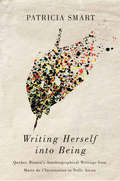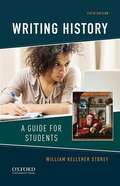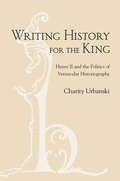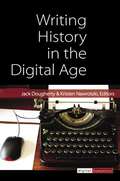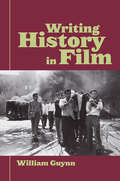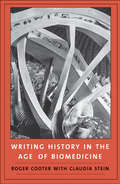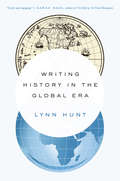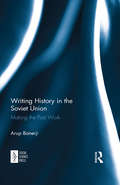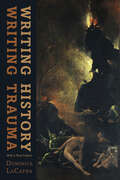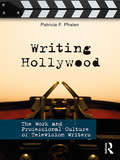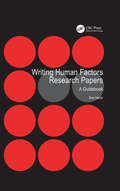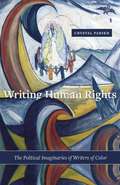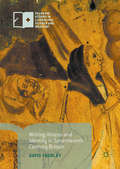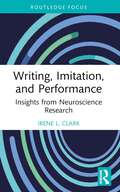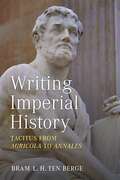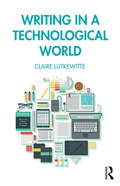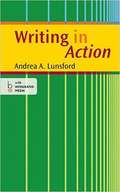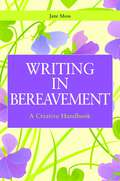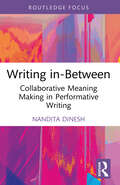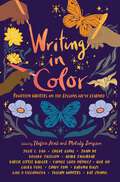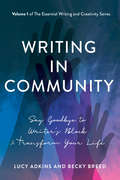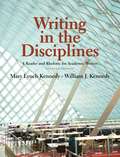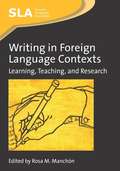- Table View
- List View
Writing Herself into Being: Quebec Women's Autobiographical Writings from Marie de l'Incarnation to Nelly Arcan
by Patricia SmartWINNER - Prix du livre d’Ottawa 2016 WINNER - Prix Jean-Éthier-Blais 2015 WINNER - Prix Gabrielle-Roy 2014 FINALIST - Prix littéraire Trillium 2015 From the founding of New France to the present day, Quebec women have had to negotiate societal expectations placed on their gender. Tracing the evolution of life writing by Quebec women, Patricia Smart presents a feminist analysis of women’s struggles for autonomy and agency in a society that has continually emphasized the traditional roles of wife and mother. Writing Herself into Being examines published autobiographies and autobiographical fiction, as well as the annals of religious communities, letters, and a number of published and unpublished diaries by girls and women, to reveal a greater range of women’s experiences than proscribed, generalized roles. Through close readings of these texts Smart uncovers the authors’ perspectives on events such as the 1837 Rebellion, the Montreal cholera epidemic of 1848, convent school education, the struggle for women’s rights in the early twentieth century, and the Quiet Revolution. Drawing attention to the individuality of each writer while situating her within the social and ideological context of her era, this book further explores the ways women and girls reacted to, and often rebelled against, the constraints imposed on them by both Church and state. Written in a clear and compelling narrative style that brings women’s voices to life, Writing Herself into Being – the author’s own translation of her award-winning French-language book De Marie de l’Incarnation à Nelly Arcan: Se dire, se faire par l’écriture intime (Boréal, 2014) – offers a new and gendered view of various periods in Quebec history.
Writing History: A Guide for Students (Fifth Edition)
by William Kelleher StoreyBringing together practical methods from both history and composition, Writing History: A Guide for Students, Fifth Edition, provides a wealth of tips and advice to help students research and write essays for history classes. Now with a lay-flat binding that further increases the book's utility, Writing History covers all aspects of writing about history, including finding and researching topics, interpreting source materials, drawing inferences from sources, and constructing arguments. It concludes with three chapters that discuss writing effective sentences, using precise wording, and revising. Using numerous examples from the works of cultural, political, and social historians, Writing History serves as an ideal text for any history course that asks students to conduct research.
Writing History for the King: Henry II and the Politics of Vernacular Historiography
by Charity UrbanskiWriting History for the King is at once a reassessment of the reign of Henry II of England (1133–1189) and an original contribution to our understanding of the rise of vernacular historiography in the high Middle Ages. Charity Urbanski focuses on two dynastic histories commissioned by Henry: Wace's Roman de Rou (c. 1160–1174) and Benoît de Sainte-Maure’s Chronique des ducs de Normandie (c. 1174–1189). In both cases, Henry adopted the new genre of vernacular historical writing in Old French verse in an effort to disseminate a royalist version of the past that would help secure a grip on power for himself and his children. Wace was the first to be commissioned, but in 1174 the king abruptly fired him, turning the task over to Benoît de Sainte-Maure.Urbanski examines these histories as part of a single enterprise intended to cement the king’s authority by enhancing the prestige of Henry II’s dynasty. In a close reading of Wace’s Rou, she shows that it presented a less than flattering picture of Henry’s predecessors, in effect challenging his policies and casting a shadow over the legitimacy of his rule. Benoît de Sainte-Maure’s Chronique, in contrast, mounted a staunchly royalist defense of Anglo-Norman kingship. Urbanski reads both works in the context of Henry’s reign, arguing that as part of his drive to curb baronial power he sought a history that would memorialize his dynasty and solidify its claim to England and Normandy.
Writing History In The Digital Age
by Jack Dougherty Kristen NawrotzkiWriting History in the Digital Age began as a “what-if” experiment by posing a question: How have Internet technologies influenced how historians think, teach, author, and publish? To illustrate their answer, the contributors agreed to share the stages of their book-in-progress as it was constructed on the public web. To facilitate this innovative volume, editors Jack Dougherty and Kristen Nawrotzki designed a born-digital, open-access, and open peer review process to capture commentary from appointed experts and general readers. A customized WordPress plug-in allowed audiences to add page- and paragraph-level comments to the manuscript, transforming it into a socially networked text. The initial six-week proposal phase generated over 250 comments, and the subsequent eight-week public review of full drafts drew 942 additional comments from readers across different parts of the globe. The finished product now presents 20 essays from a wide array of notable scholars, each examining (and then breaking apart and reexamining) if and how digital and emergent technologies have changed the historical profession.
Writing History in Film
by William GuynnHistorical film has been an important genre since the earliest silent films. The French Revolution, the American Civil War, the conquest of the New World, World War II--all have been repeatedly represented in film. But how do we distinguish between fictionalized spectacle and authentic historical representation? Writing History in Film sets out the narratological, semiological, rhetorical, and philosophical bases for understanding how film can function as a form of historical interpretation and representation. With case studies and an interdisciplinary approach, William Guynn examines the key issues facing film students and scholars, historians, and anyone interested in how we see our historical past.
Writing History in the Age of Biomedicine
by Roger Cooter Claudia SteinA collection of ten essays paired with substantial prefaces, this book chronicles and contextualizes Roger Cooter's contributions to the history of medicine. Through an analysis of his own work, Cooter critically examines the politics of conceptual and methodological shifts in historiography. In particular, he examines the "double bind" of postmodernism and biological or neurological modeling that, together, threaten academic history. To counteract this trend, suggests Cooter, historians must begin actively locating themselves in the problems they consider.The essays and commentaries constitute a kind of contour map of history's recent trends and trajectories--its points of passage to the present--and lead both to a critical account of the discipline's historiography and to an examination of the role of intellectual frameworks and epistemic virtues in the writing of history.
Writing History in the Global Era
by Lynn HuntLeading historian Lynn Hunt rethinks why history matters in today's global world and how it should be written. George Orwell wrote that "history is written by the winners." Even if that seems a bit too cut-and-dried, we can say that history is always written from a viewpoint but that viewpoints change, sometimes radically. The history of workers, women, and minorities challenged the once-unquestioned dominance of the tales of great leaders and military victories. Then, cultural studies--including feminism and queer studies--brought fresh perspectives, but those too have run their course. With globalization emerging as a major economic, cultural, and political force, Lynn Hunt examines whether it can reinvigorate the telling of history. She hopes that scholars from East and West can collaborate in new ways and write wider-ranging works. At the same time, Hunt argues that we could better understand the effects of globalization in the past if we knew more about how individuals felt about the changes they were experiencing. She proposes a sweeping reevaluation of individuals' active role and their place in society as the keys to understanding the way people and ideas interact. She also reveals how surprising new perspectives on society and the self--from environmental history, the history of human-animal interactions, and even neuroscience--offer promising new ways of thinking about the meaning and purpose of history in our time.
Writing History in the Soviet Union: Making the Past Work
by Arup BanerjiThe history of the Soviet Union has been charted in several studies over the decades. These depictions while combining accuracy, elegance, readability and imaginativeness, have failed to draw attention to the political and academic environment within which these histories were composed. Writing History in the Soviet Union: Making the Past Work is aimed at understanding this environment. The book seeks to identify the significant hallmarks of the production of Soviet history by Soviet as well as Western historians. It traces how the Russian Revolution of 1917 triggered a shift in official policy towards historians and the publication of history textbooks for schools. In 1985, the Soviet past was again summoned for polemical revision as part and parcel of an attitude of openness (glasnost') and in this, literary figures joined their energies to those of historians. The Communist regime sought to equate the history of the country with that of the Communist Party itself in 1938 and 1962 and this imposed a blanket of conformity on history writing in the Soviet Union. The book also surveys the rich abundance of writing the Russian Revolution generated as well as the divergent approaches to the history of the period. The conditions for research in Soviet archives are described as an aspect of official monitoring of history writing. Another instance of this is the manner by which history textbooks have, through the years, been withdrawn from schools and others officially nursed into circulation. This intervention, occasioned in the present circumstance by statements by President Putin himself, in the manner in which history is taught in Russian schools, continues to this day. In other words, over the years, the regime has always worked to make the past work. Please note: Taylor & Francis does not sell or distribute the Hardback in India, Pakistan, Nepal, Bhutan, Bangladesh & Sri Lanka
Writing History, Writing Trauma (Parallax: Re-visions of Culture and Society)
by Dominick LaCapraAn updated edition of a major work in trauma studies.Trauma and its aftermath pose acute problems for historical representation and understanding. In Writing History, Writing Trauma, Dominick LaCapra critically analyzes attempts by theorists and literary critics to come to terms with trauma and with the crucial role post-traumatic testimonies—notably Holocaust testimonies—assume in thought and in writing. These attempts are addressed in a series of six interlocking essays that adapt psychoanalytic concepts to historical analysis, while employing sociocultural and political critique to elucidate trauma and its aftereffects in culture and in people. This updated edition includes a substantive new preface that reconsiders some of the issues raised in the book.
Writing Hollywood: The Work and Professional Culture of Television Writers
by Patricia F. PhalenWriting Hollywood highlights the writing process in the production of television drama and comedy series in the U.S. The way writers do their jobs is heavily dependent not only on the demands of commercial business, but also on the uncertainties inherent in a writing career in Hollywood. Drawing on literature in the fields of Media Industry Studies and Occupational Culture, Writing Hollywood explains writers’ efforts to control risk and survive in a constantly changing environment. Using data from personal interviews and a six-week participant observation at a prime time drama, Dr. Phalen analyzes the relationships among writers in series television, describes the interactions between writers and studio/network executives, and explains how endogenous and exogenous pressures affect the occupational culture of the television writing profession.
Writing Human Factors Research Papers: A Guidebook
by Don HarrisWriting high-quality papers suitable for publication within international scientific journals is now an essential skill for all early-career researchers; their career progression and the reputation of the department in which they work depends upon it. However, many manuscripts are rejected or sent back for major re-working not because the science they contain is in any way 'bad', but because the same problems keep occurring in the way that the material is presented. It is one thing to write a good scientific paper, however it is quite another thing to get it published. This requires some additional nous. In writing this book Don Harris draws upon nearly a quarter of a century of experience as an author and reviewer of research papers, and ultimately as a journal editor. By his own admission, it contains all the things he wished that his mentors had told him 25 years ago, but didn't. The material in the book is drawn from many years of finding all these things out for himself, usually by trial and error (but mostly error!). The text adopts a much lighter touch than is normally found in books of this type - after all, who really wants to read a book about writing research papers? The author describes his own unique approach to writing journal papers (which, in his own words, has proved to be extremely successful). All major points are illustrated with examples from his own, published works. The book is written in the form of a manual for constructing a journal manuscript: read a chapter, write a section. However, the material it contains goes beyond just this and also describes how to select a target journal, the manuscript submission process, what referees are looking for in a good journal paper, and how to deal with the referees' comments. Each chapter concludes with a checklist to ensure all the key elements have been addressed.
Writing Human Rights: The Political Imaginaries of Writers of Color
by Crystal ParikhThe legal texts and aspirational ideals of human rights are usually understood and applied in a global context with little bearing on the legal discourse, domestic political struggles, or social justice concerns within the United States. In Writing Human Rights, Crystal Parikh uses the international human rights regime to read works by contemporary American writers of color—Toni Morrison, Chang-rae Lee, Ana Castillo, Aimee Phan, and others—to explore the conditions under which new norms, more capacious formulations of rights, and alternative kinds of political communities emerge.Parikh contends that unlike humanitarianism, which views its objects as victims, human rights provide avenues for the creation of political subjects. Pairing the ethical deliberations in such works as Beloved and A Gesture Life with human rights texts like the United Nations Convention Against Torture, she considers why principles articulated as rights in international conventions and treaties—such as the right to self-determination or the right to family—are too often disregarded at home. Human rights concepts instead provide writers of color with a deeply meaningful method for political and moral imagining in their literature.Affiliating transnational works of American literature with decolonization, socialist, and other political struggles in the global south, this book illuminates a human rights critique of idealized American rights and freedoms that have been globalized in the twenty-first century. In the absence of domestic human rights enforcement, these literatures provide a considerable repository for those ways of life and subjects of rights made otherwise impossible in the present antidemocratic moment.
Writing Illness and Identity in Seventeenth-Century Britain
by David ThorleyThis book is a survey of personal illness as described in various forms of early modern manuscript life-writing. How did people in the seventeenth century rationalise and record illness? Observing that medical explanations for illness were fewer than may be imagined, the author explores the social and religious frameworks by which illness was more commonly recorded and understood. The story that emerges is of illness written into personal manuscripts in prescriptive rather than original terms. This study uncovers the ways in which illness, so described, contributed to the self-patterning these texts were set up to perform.
Writing Illness and Identity in Seventeenth-Century Britain (Palgrave Studies in Literature, Science and Medicine)
by David ThorleyThis book is a survey of personal illness as described in various forms of early modern manuscript life-writing. How did people in the seventeenth century rationalise and record illness? Observing that medical explanations for illness were fewer than may be imagined, the author explores the social and religious frameworks by which illness was more commonly recorded and understood. The story that emerges is of illness written into personal manuscripts in prescriptive rather than original terms. This study uncovers the ways in which illness, so described, contributed to the self-patterning these texts were set up to perform.
Writing, Imitation, and Performance: Insights from Neuroscience Research (Routledge Research in Writing Studies)
by Irene L. ClarkThis book reconsiders imitation as a valuable pedagogical approach in Writing Studies. Countering concerns about product-oriented teaching, formulaic writing, paternalistic or elitist pedagogy, and plagiarism, the book maintains that the use of imitation can offer a writer greater insight and help to develop a clear writerly identity. Positing that writers often use imitation as a step toward developing new directions, structures, and styles, and that this imitation is indeed a form of performance, the author explores the neuropsychological aspect of imitation to show how it is a valid form of writing instruction. She explains how learning, experience, and role playing are manifested in the brain and influence one’s sense of self, one’s identity. The book emphasizes that imitation can provide students with opportunities to perform habitually as writers, readers, and critical thinkers, enabling them to develop new understandings and confidence in their ability to improve. It also includes suggestions for classroom application, written by Craig A. Meyer. This book offers important insights for scholars and teachers of writing and composition, education, and communication studies.
Writing Imperial History: Tacitus from Agricola to Annales
by Bram ten BergeThe late first- and early second-century Roman senator and historian Cornelius Tacitus, whom Edward Gibbon described as “the first of the historians who applied the science of philosophy to the study of facts,” shaped the development of the modern understanding of history as a crucial vehicle for social analysis. The breadth of his thinking is fully revealed only through analysis of how the political, geographical, and rhetorical theories expounded in his early works influenced his later narrative of the evolution of the Roman monarchy. Tacitus, who was one of the oratorical luminaries of his time, produced a collection of works widely recognized as offering the most authoritative account of Rome’s early imperial history. His oeuvre traditionally is divided into the so-called minor and major works. Writing Imperial History offers the first comprehensive analysis of Tacitus’ five texts and their interconnections and serves to confront longstanding assumptions that have led to a fundamental misunderstanding of the nature and development of his oeuvre and historical thinking. Tracing many of the enduring themes and concerns that Tacitus explores across his works, the book shows how the vision articulated in his earlier texts persists in his later ones and how he used the former as sources for the latter.
Writing in a Technological World
by Claire LutkewitteWriting in a Technological World explores how to think rhetorically, act multimodally, and be sensitive to diverse audiences while writing in technological contexts such as social media, websites, podcasts, and mobile technologies. Claire Lutkewitte includes a wealth of assignments, activities, and discussion questions to apply theory to practice in the development of writing skills. Featuring real-world examples from professionals who write using a wide range of technologies, each chapter provides practical suggestions for writing for a variety of purposes and a variety of audiences. By looking at technologies of the past to discover how meanings have evolved over time and applying the present technology to current working contexts, readers will be prepared to meet the writing and technological challenges of the future. This is the ideal text for undergraduate and graduate courses in composition, writing with technologies, and professional/business writing. A supplementary guide for instructors is available at www.routledge.com/9781138580985
Writing In Action
by Andrea A. LunsfordAndrea Lunsford’s research treats student writers as writers first—not only in the classroom, but in every aspect of their lives. Her newest handbook features a simple and inviting design that helps students find solutions for every situation as they translate their skills as writers in their day-to-day lives to the conventions of solid academic writing. Featuring the writing process coverage of larger handbooks at a value price, Writing in Action is a supportive reference that emphasizes rhetorical strategies that help students put their ideas into action.
Writing in Action (Level A)
by K12 Inc.Writing to a Prompt, Writing a Report, Writing Poetry, Writing from Personal Experience
Writing in Bereavement: A Creative Handbook
by Gillie Bolton Jane MossWriting in Bereavement is a practical creative handbook that will assist counsellors, volunteers and others in their work with bereaved adults. Writing is a powerful outlet for the emotions that accompany grief and it is therefore a valuable therapeutic tool to help those who are bereaved communicate their experiences and adjust to life after their loss. Jane Moss provides imaginative creative writing exercises for groups and individuals, using a variety of genres and literary forms and techniques. She offers advice on how to plan and run successful workshops with the bereaved, and how to evaluate their effectiveness. Using the techniques in this book, counsellors can help grieving individuals find a voice to cope with profound changes in their life, complete unfinished conversations, write for remembrance, use creativity as a respite from sadness, and finally begin to move forward from grief and imagine the future.
Writing in-Between: Collaborative Meaning Making in Performative Writing (Routledge Focus on Literature)
by Nandita DineshWriting in-Between lies at intersections: between theory and praxis; between fiction and non-fiction; between author and reader; between the personal and the political. Beginning with a conceptual glossary that prepares readers for their journey through the book, Dinesh offers two central texts to invite readers to become co-creators. The first, F for _____, is written as an “academic novella” and culminates with an interactive section that is composed of guided invitations for the reader/co-creator. The second text, Julys, takes the form of a “dramatic memoir” and intersperses invitations for readers/co-creators between each of its chapters. Dinesh brings these threads together in an entirely interactive concluding chapter, where her hopes for collaborative meaning making take centre stage. In all of its unique invitations to engage, Dinesh’s readers/co-creators can either choose to craft their creations in personal notebooks or blank spaces in this work’s physical copy, or to engage more publicly via virtual forums that can be accessed via QR codes and accompanying links that are scattered throughout the book. Guided by questions about writing can “do” — questions that have shaped Dinesh’s work as an artist, scholar, and educator for almost two decades — Writing in Between embodies one central tenet: that the significance of performative writing might be most powerfully experienced through a collaborative process of meaning making between a text’s author and its readers turned co-creators.
Writing in Color: Fourteen Writers on the Lessons We've Learned
by Julie C. Dao Chloe Gong Joan He Kosoko Jackson Adiba Jaigirdar Darcie Little Badger Yamile Saied Méndez Axie Oh Laura Pohl Cindy Pon Karuna Riazi Gail D. Villanueva Julian Winters Kat ZhangRethink the way you approach writing in this &“honest, useful craft book that all fledgling writers need&” (Kirkus Reviews, starred review) from fourteen diverse authors that demystifies craft and authorship based on their experiences as writers of color—perfect for fans of Fresh Ink and Our Stories, Our Voices.So, you&’re thinking of writing a book. Or, maybe you&’ve written one, and are wondering what to do with it. What does it take to publish a novel, or even a short story? If you&’re a writer of color, these questions might multiply; after all, there&’s a lot of writing advice out there, and it can be hard to know how much of it really applies to your own experiences. If any of this sounds like you, you&’re in the right place: this collection of essays, written exclusively by authors of color, is here to encourage and empower writers of all ages and backgrounds to find their voice as they put pen to page. Perhaps you&’re just getting started. Here you&’ll find a whole toolkit of advice from bestselling and award-winning authors for focusing on an idea, landing on a point of view, and learning which rules were meant to be broken. Or perhaps you have questions about everything beyond the first draft: what is it really like being a published author? These writers demystify the process, sharing personal stories as they forged their own path to publication, and specifically from their perspectives as author of color. Every writer has a different journey. Maybe yours has already started. Or maybe it begins right here. Contributors include: Julie C. Dao, Chloe Gong, Joan He, Kosoko Jackson, Adiba Jaigirdar, Darcie Little Badger, Yamile Saied Méndez, Axie Oh, Laura Pohl, Cindy Pon, Karuna Riazi, Gail D. Villanueva, Julian Winters, and Kat Zhang.
Writing in Community: Say Goodbye to Writer's Block and Transform Your Life
by Lucy Adkins Becky BreedWriting in Community is a book of inspiration and encouragement for writers who want to reach deep within themselves and write to their fullest potential. There is magic in a successful writing group. This book helps writers tap into that magic, and with gentle wisdom and humor, experience unprecedented breakthroughs in creativity.
Writing In The Disciplines: A Reader And Rhetoric For Academic Writers
by Mary Lynch Kennedy William J. KennedyThis rhetoric/anthology instructs college students in how to read academic texts with understanding and how to use them as sources for papers in a variety of disciplines. <P><P>In Writing in the Disciplines, Mary Kennedy and William Kennedy emphasize academic writing as ongoing conversations in multiple genres, and do so in the context of WPA Outcomes. <P><P>The rhetoric chapters teach critical reading, paraphrasing, summarizing, quoting, writing process, synthesizing, analyzing, researching, and developing arguments. <P><P>The anthology balances journal articles with works by public intellectuals in the sciences, social sciences, and humanities.
Writing in Foreign Language Contexts
by Rosa ManchonThis book represents the most comprehensive account to date of foreign language (FL) writing. Its basic aim is to reflect critically on where the field is now and where it needs need to go next in the exploration of FL writing at the levels of theory, research, and pedagogy, hence the two parts of the book: 'Looking back' and 'Looking ahead'. The chapters in Part I offer accounts of both the inquiry process followed and the main insights gained in various long-term research programs. The chapters in Part 2 contribute a retrospective analysis of the available empirical research and of professional experiences in an attempt to move forward. The book invites the reader to step back and rethink seemingly well established knowledge about L2 writing in light of what is known about writing in FL contexts.
